Traditional German Spaetzle Recipe
This post may contain affiliate links. See my disclosure policy.
One of Germany’s most popular and beloved foods, here is a fool-proof and authentic German Spaetzle recipe, just the way my Mutti and Oma made it! Perfect texture and perfect flavor, these are just like you know and love them from the Swabia region of Southern Germany where they originated!
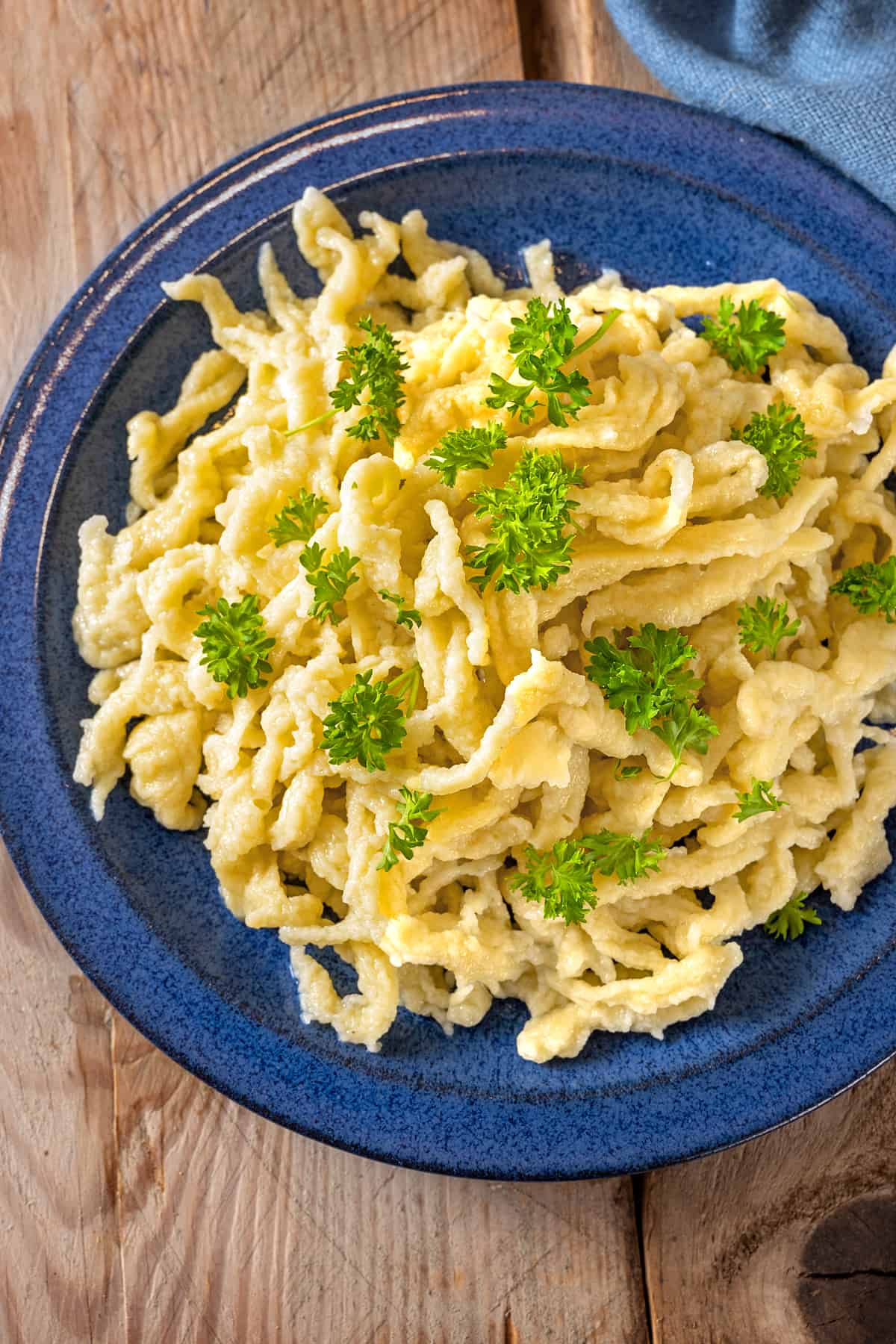
What is Spaetzle?
One of the most beloved foods in Germany that tourists go home talking about is Spaetzle, the famous German egg noodles from the Baden-Württemberg region of southwest Germany. This area is also known as Schwabenland, or Swabia. I grew up in Stuttgart, the capital of Baden-Württemberg, watching my Mom and Oma make Spätzle – I learned from the best!
Swabia is home to some of Germany’s best food (many, including myself, will argue it’s home to the best food in all of Germany). And that’s saying a lot because every region of Germany has amazing food. Swabia is known for its soups, sauces, meats, wursts, and salads, to name a few. It’s also home to some unique varieties of pasta including Spätzle, Schupfnudeln and Maultaschen.
Today we’re featuring Spätzle, a Swabian specialty that is also enjoyed in Austria and Switzerland. Spaetzle is a special type of egg noodle that is enjoyed with sauces and gravies as well as incorporated into a variety of different dishes. One example is Käsespätzle (a cheese spatzle casserole with crispy fried onions). Where did the name “Spätzle” originate? It comes from the German word Spatzen, meaning “little sparrows”, because that’s what they were thought to resemble when they were traditionally made by hand.
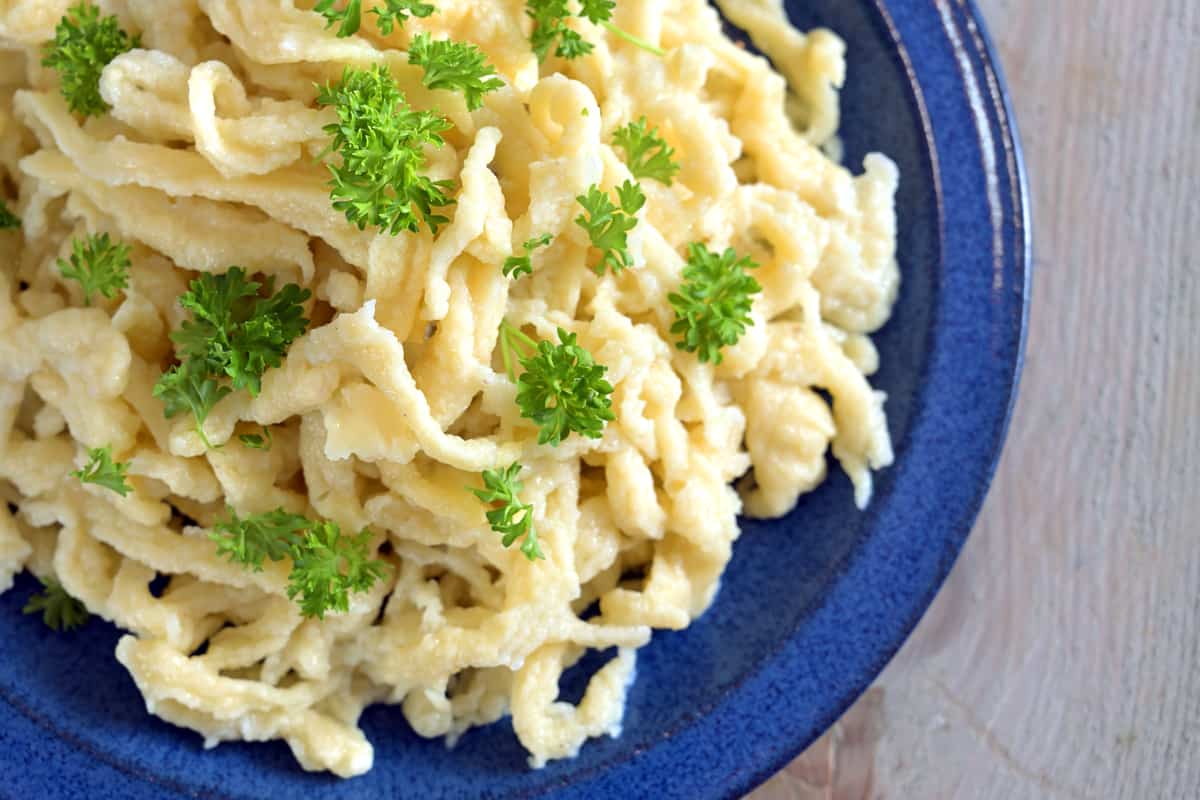
Spaetzle Ingredients
Spaetzle is a type of pasta and as such is made with a very few, simple ingredients that you’ll already have in your pantry. Here’s what you need:
- All-purpose flour: this creates a tender Spaetzle that still has a nice chewy texture.
- Eggs: these add richness and contribute to texture.
- Milk or water: You can use either but I prefer milk as it adds richness.
- Salt: enhances the flavor.
- Nutmeg: this is optional and is not traditional, though many German cooks today like to add it for flavor.
Spaetzle Recipe
Let’s get started!
This spaetzle recipe uses a stand mixer to knead/mix the dough. This is actually the first time I’ve made it that way. I’ve always done it by hand (you “knead” it by vigorously whipping it in a bowl with a spoon – over and over and over for around 20 minutes. It’s a lot of work!) I decided to to try it with a stand mixer instead and it turned every bit as good – and it sure saves a lot of muscle strain!
Add the flour and salt in the bowl of a stand mixer. Stir to combine. Crack four eggs into a bowl and whisk to combine. Make a well in the center of the flour and add the eggs. Add the milk or water and with the paddle attachment (I initially tried the dough hook and it didn’t work well), knead/mix the dough on the “2” setting for about 10 minutes to get a cohesive batter. Add more flour if the mixture is too runny, or more milk if it is too stiff.
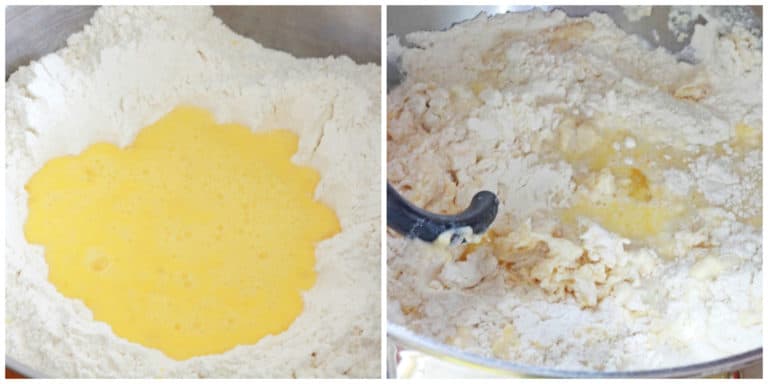
Pro Tip: How to Know When the Spätzle Batter is Ready
The batter is done when “bubbles” begin to form. After about 10 minutes of beating, use a wooden spoon and scoop and pull to stretch the batter; if bubbly holes appear, the dough is done. If not, continue “kneading” with the mixer for another minute or two, repeating the “test” process. See the bubble hole below?
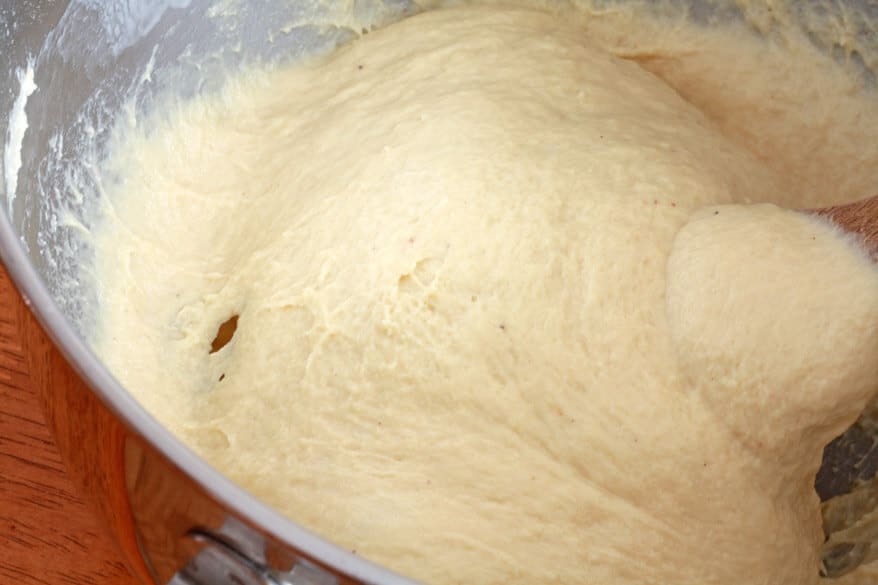
When those bubbly holes start appearing you know your batter is done.
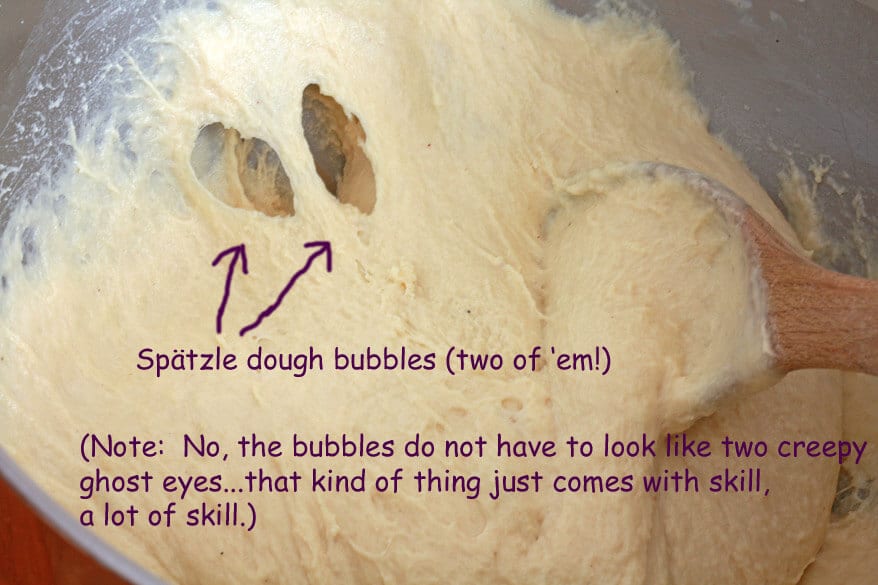
What Is the Best Spätzle Maker?
Now that the batter is read it’s time to make the Spätzle. And when it comes to the Spaetzle maker, there are a few options to choose from. Traditionally, Spätzle was made by hand using a Spätzlebrett, or Spaetzle board. You would rub a slab of dough out onto a wetted board and use a pastry cutter or long sharp knife to quickly cut off strands of the dough into simmering water. Swabian women of previous generations were highly skilled at this and could do it so fast it would make you dizzy to watch. Nowadays most Germans use a Spätzle maker (and even more just buy it ready made at the store. It’s the “convenience generation”).
Besides the traditional Spätzle board there are a few different kinds of Spätzle makers out there that you can find online:
- Spätzle Press (below left): That is my Spaetzle maker that I brought with me from Germany when I moved to the U.S. and it’s awesome. This kind is pricey but it will last a lifetime. It’s called the Original Kull Spätzle Maker and is made in Germany. It’s built like a tank and will become a family heirloom you can pass down for generations. Another brand that is much cheaper and is also made in Germany is this Westmark Spätzle Maker. These Spätzle presses can also be used as potato ricers.
- Spätzle Scraper (below right): Another option is the Küchenprofi Spätzle Lid & Scraper. I’ve used this one as well with good results and it’s much cheaper. It produces a shorter, stubbier spatzle noodle. Alternatively you can also use a metal steamer because it’s similarly constructed with large holes. You place some of the dough in the steamer over the simmering water and scrape the dough through the holes.
- Spätzle Plane: A third option is the Küchenprofi Spätzle Plane with Pusher, which is my least favorite as it can be a little clumsy, messy, and more difficult to work with but I know people who use it.
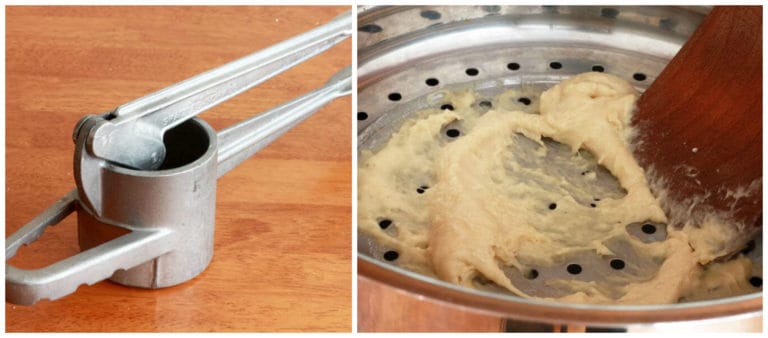
My personal favorite is the Spätzle press and that’s what I’m using in the pictures below. Place the Spaetzle maker over a pot of lightly salted simmering water and scoop some dough into it.
Press the Spätzle maker down to squeeze the Spätzle noodles out into the simmering water. Simmer the Spätzle for about 2-3 minutes or until they float to the top.
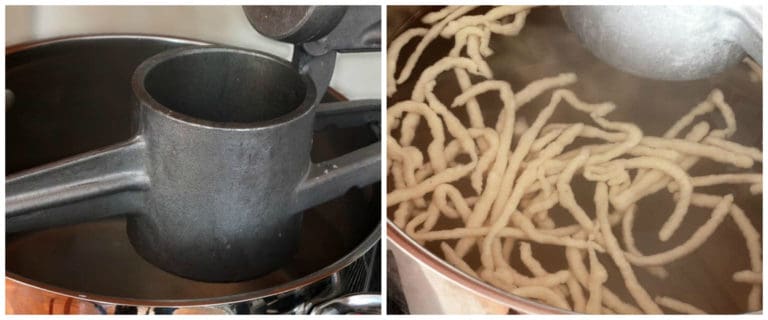
Using a slotted spoon, transfer the Spätzle to a colander and then immediately put them in a bowl of very cold water. This helps them firm up to the desired consistency.
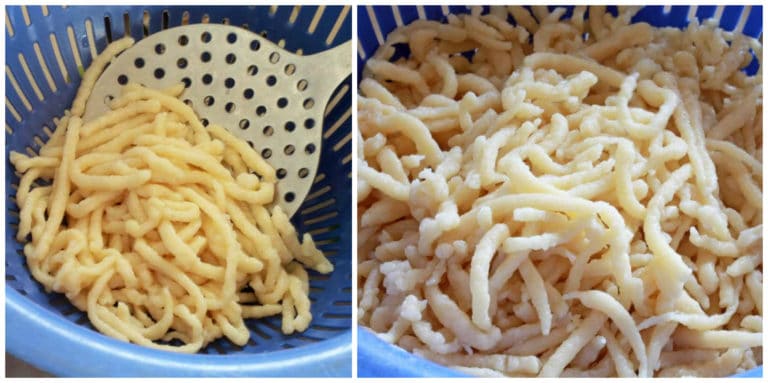
Drain the Spätzle again and toss with a little oil or melted butter to keep them from sticking.
Spätzle will keep in the fridge for at least a couple of days and then heated to serve. Melt some butter in a pan and toss the Spaetzle in it to warm through.
Storage & Freezing
Spaetzle can be made in advance, cooled, and stored in a covered container in the fridge where it will keep for 3-4 days. To reheat it you can microwave it in a microwave-safe container or, my favorite way, is to melt some butter in a large skillet, add the Spätzle and heat through. Spaetzle also freezes well for up 3 months: put it in a freezer-safe container and let it thaw overnight in the fridge. It can be reheated in the microwave in a covered container so that it doesn’t dry out, or you can melt some butter in a pan and toss the Spaetzle in it until warmed through.
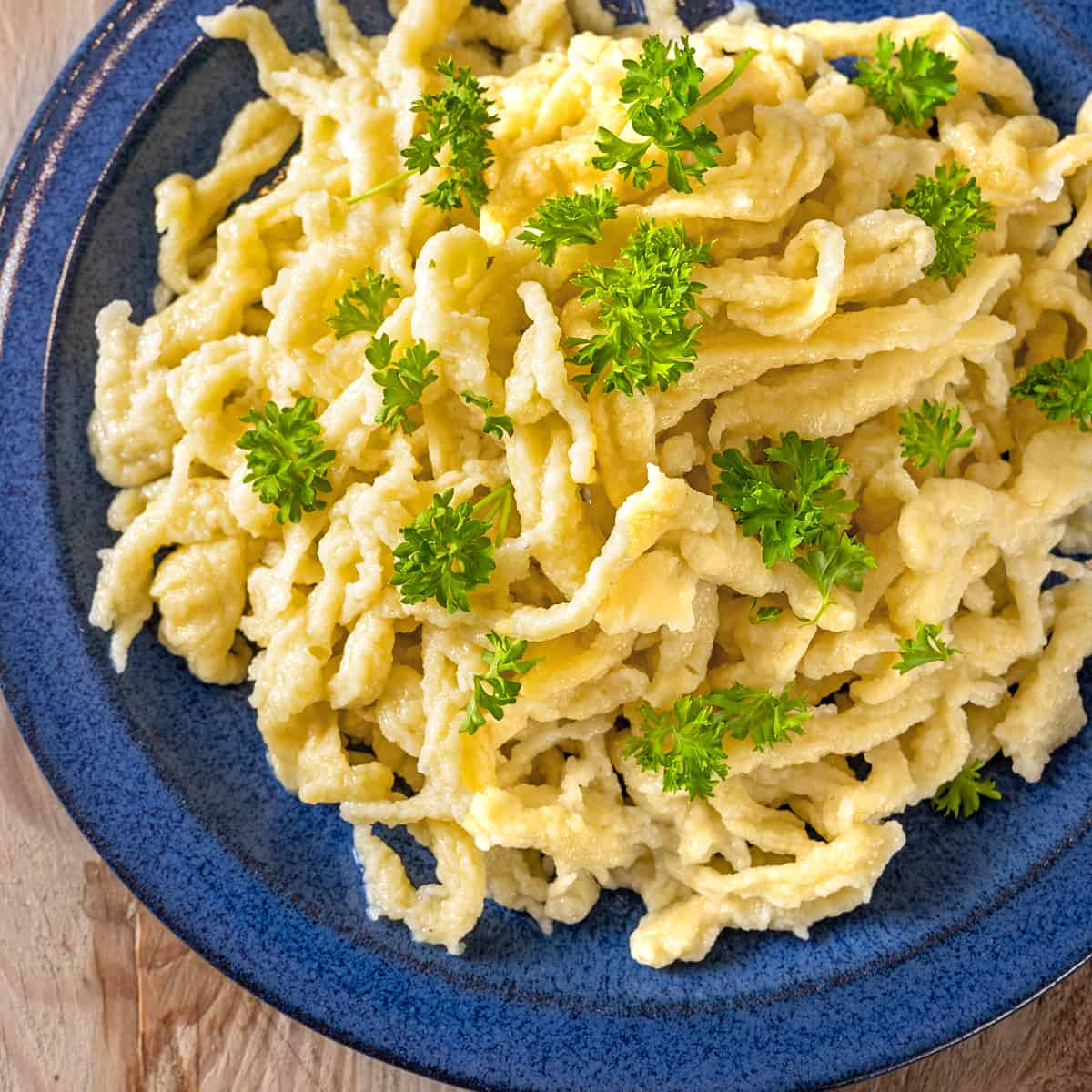
What to Serve with Spaetzle
Spaetzle is very versatile and can be served a variety of ways. Here are a ways to serve spaetzle:
- Buttered Spätzle: This is one of the simplest and most traditional ways to serve spaetzle. After boiling and draining the cooked spaetzle, toss them with melted butter and sprinkle with chopped parsley.
- German Cheese Spaetzle (Käsespätzle): Another Swabian classic and personal favorite, try my recipe for Käsespätzle (pictured below).
- With Sauces and Gravies: Spaetzle can be served with any sauce or gravy, like my favorite German Rahm Sauce, Onion Gravy, or Mushroom Gravy. Serve it with my classic German Goulash, Geschnetzeltes or Königsberger Klopse.
- With Meat Dishes: Spaetzle is the perfect choice to serve with any saucy meat dish like Jagerschnitzel, Rouladen, Sauerbraten, Pot Roast and Tri Tip Roast. It can also accompany your Schweinshaxe and Frikadellen.
- Pasta Salads: For a variation on traditional pasta salad, toss the spaetzle with fresh vegetables, herbs, a vinaigrette, and some diced cheese and ham.
- In Soups: In some regions, spaetzle is added to soups, much like dumplings. Drop small portions of spaetzle dough directly into simmering soup and let them cook until they float to the surface as in this Gaisburger Marsch and German Pea Soup.
Guten Appetit!
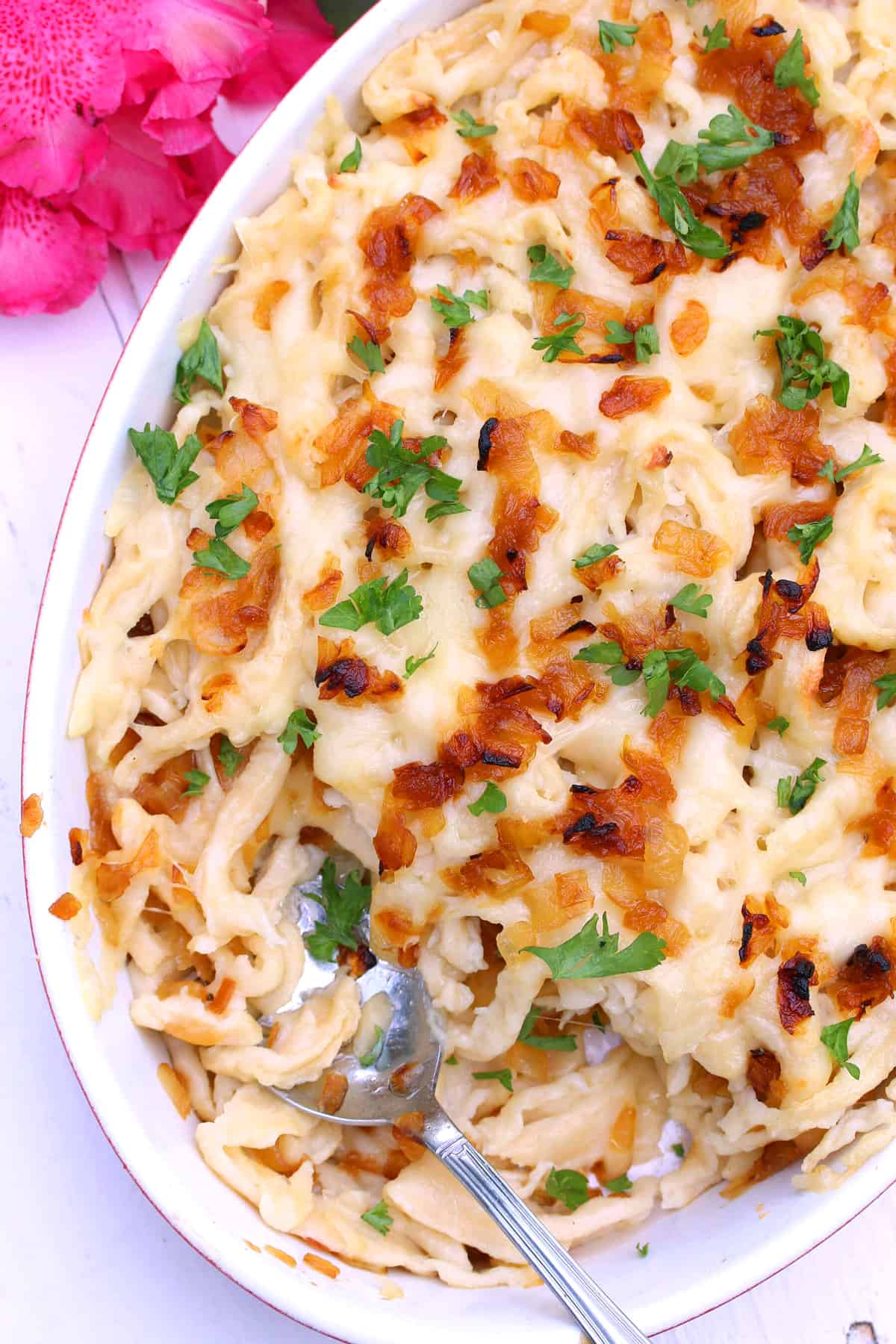
For more favorite traditional German dishes be sure to try my:
- Kaesespaetzle
- Rouladen
- Sauerbraten
- German Goulash
- Maultaschen
- Schnitzel
- Bread Dumplings
- German Potato Dumplings
- Zwiebelkuchen
- German Bread (Vollkornbrot)
- Bratwurst
- Currywurst
- German Potato Salad
- Rotkohl
Save This Recipe
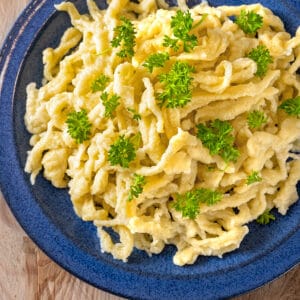
Traditional German Spaetzle Recipe
Equipment
Ingredients
- 2 cups all-purpose flour (you can also use whole wheat flour)
- 1 1/2 teaspoons salt
- 1/8 teaspoon freshly ground nutmeg , optional (not traditional but adds a nice flavor)
- 4 large eggs
- 1/2 cup milk or water + more as needed (milk produces a richer Spaetzle) (**add more flour if the dough is too runny, add more milk or water if it's too stiff)
- butter for serving
Instructions
- The Spätzle batter can be mixed by hand or by using a stand mixer which is much easier. Add the flour, salt and nutmeg (if using) to the bowl of a stand mixer. Stir to combine. Crack the eggs into a small bowl and whisk them. Make a well in the center of the flour mixture and pour the eggs in it. Add the milk (start with using slightly less and add more as needed). Attach a paddle attachment to the stand mixer and "knead" the dough for about 10 minutes or until bubbles appear (see pictured instructions for details). After 10 minutes or so of beating, use a wooden spoon to scoop and pull the dough. If bubbles/holes appear, the dough is done
- Bring at least 2 quarts of lightly salted water to a boil, then reduce to a simmer. Using a Spätzle maker of your choice (I use and prefer the Spätzle press), press the noodles into the simmering water and cook for about 2-3 minutes, or until the noodles float to the top. Use a slotted spoon to transfer the noodles to a colander to drain the hot water and then to large bowl of ice water (this firms them up for a better/chewier texture). After a minute or two transfer them to a colander to drain completely. Before serving, warm them through in a skillet with some melted butter.
- Make Ahead: The Spaetzle can be stored in the fridge for at least a couple of days and then reheated. Melt some butter in a large skillet and toss the Spätzle in it to heat through. Alternatively they can be microwaved in a covered dish.
Notes
Nutrition
Originally published on The Daring Gourmet on August 3, 2013



















This has been my go-to recipe for Spaetzle for the past 8 years. It turns out perfectly every time. I’m German, from Augsburg, and have been living in Australia for the past 22 years, but when I want a taste of home I use your recipes. They have never failed me. I love them all, especially the German ones. Your devoted fan from Down Under, Gisela.
I can’t tell you how happy I am to hear that, Gisela! Thank you so much for that kind compliment and thank you for your support all these years <3
Hi Kimberly. These look delicious. Please could you answer Chris’s question? You probably missed it because he/she posted it at lunchtime on Christmas Eve (2023). I have never tasted these noodles, but would love to make them when I’ve found room in my kitchen for a food mixer! So Chris’s question might just be the one I need an answer to, when I try to make them. 😂 I’d be interested to read your answer
Hi Alex, thanks for bringing that to my attention. Here is my response to Chris’ question: “Once you start pressing the batter through the weight of it should pull downwards creating long strands. If that’s not happening then the dough is much too thick and needs a little more water added.”
My Grandmother made these all the time. My dad side is German so I grew up with a lot of traditional German food. One way she made them was after boiling and cooking she would then fry them in butter and onions. She would just cut the dough out of the bowl over boiling water.
Thanks for sharing, Ashley! I love these fried in butter as well and the addition of some caramelized onions makes practically everything better :)
This made phenomenal spatzle with the perfect texture. Made it along with your mushroom gravy and I got compliments from all around the table.
Oh I am so glad it was a hit, Tanner, thank you so much!
The recipe is great and the taste is Smecht however using my press the spaetzle comes out in balls rather than string noodles. What could I be doing wrong
Hi Chris, once you start pressing the batter through the weight of it should pull downwards creating long strands. If that’s not happening then the dough is much too thick and needs a little more water added.
My friends from Neckarsulm used nutmeg. Their grandma still lived in the Black Forest. My husband remembers nutmeg from his time in Garmisch in the 70s…. Very curious why nutmeg is considered not traditional?
Hi Janis, the oldest Swabian recipes don’t use it, it’s more of a contemporary addition. And by contemporary I mean within the last few decades :) It’s also in part a regional thing; though Spätzle originated in Swabia it’s now popular throughout Germany and it’s possible that other regions use nutmeg more frequently.
Can the dough be made a day in advance and stored in the fridge?
Hi Yvonne, yes it can. Alternatively the Spätzle can also be fully made and cooked in advance and reheat very well.
Emmm, hesitate to ask, but I’m coeliac…can they be made gluten-free ? Thanks.
Hi Marilyn, I have not tried it but I’ve had readers report that they used an all-purpose GF flour blend (1:1 substitute) with success.
FRIED Spaetzle, now even a Dithmarscher likes THAT
Love it with nutmeg
I have been making your recipe for year’s; however, the one I have from you has hand grated nutmeg and 4 cups of flour with 4 eggs. This recipe uses 2 cups of flour with 4 eggs but no nutmeg. Did you change your recipe?
Hi Karen, I did. Both ratios can be used with complete success and just yield different textures. The original version produces a softer Spätzle. The updated version with the higher ratio of eggs produces a “chewier” Spätzle which I by and large prefer. Nutmeg is something that some cooks add but it isn’t very traditional so I decided to omit it from this traditional version. Having made the original version I’d encourage you to try this version and see which one you prefer. And you can certainly still add some nutmeg if you prefer.
My mom remembers her mom making German Bread Dumplings. From what my mom and cousin remember the bread was placed on top of potatoes and water in a Dutch oven. The lid was placed and you couldn’t open it until you heard the pop.
I’ve searched for a recipe like this but can’t find one.
Would you have any thoughts on this?
Your spaetzel is delicious.
Thank you
Thank you, Penny :) I’ve never heard of anything resembling that method, I think that was likely her own approach. Here is a very traditional German bread dumplings recipe: https://www.daringgourmet.com/semmel-knoedel-german-bread-dumplings/.
I made these for my German mom’s birthday and everyone loved them! I was really worried about the consistency (didn’t know if they were too thick or too thin) but frying them up in butter made them perfect.
I’m so glad, Nadya, thank you!
I make thes to go with my corned beef and cabbage. I always add butter. Sometimes, I fry some bacon, then saute the spaetzel in some of the bacon grease and add the crumbled bacon. Oh my!
That sounds terrific, Barbara. My motto is that practically everything tastes better with bacon! :)
At last a recipe to make them. But can you freeze them?
Hi Heidi, you sure can! Let them thaw and use them as you normally would.
I have been making your recipe in the mixer for years now and it never fails me. Now I have it all together. A proper recipe, the right kind of flour and a mixer. My spaetzle is wunderbar! Danke.
Fantastic, Suzanne, thank you so much!